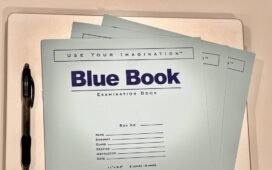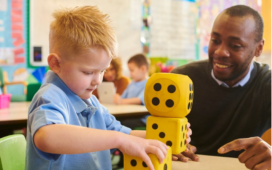Ki Sung: Traci Thomas, you read a lot of books, and in your podcast, you also talk about a book you’re reading with your twin boys – the minis as you call them. I don’t know if you’re done with that book, but tell me about your experience reading it with your kids.
Traci Thomas: Yes. So I call my kids the mini stacks. They are almost five now, identical twin boys. And we are reading Charlotte’s Web, which was one of my favorite books as a kid. And we started reading it out loud, chapter by chapter. We’re not super far. And there’s about, I think, 35 chapters in the book. So we’re around chapter five right now. Some nights we just read a picture book. But it’s been really special because I wasn’t sure they were old enough to read a chapter book. And they’re loving it. When they’re at the end of each chapter, I say to them, So what happened? And they’ll say they were going to get rid of the pig because he was small, but the girl kept them. So it’s been really fun to kind of listen to them as they take in one of my absolute favorite books.
Ki Sung: And why is it a favorite of yours? What is your memory of Charlotte’s Web?
Traci Thomas: So my memory as a child of Charlotte’s Web was just that. I loved the characters. I loved Charlotte, I loved Wilbur. I loved the mouse so much. The rat who eats the Smorgasbord, which is like my favorite word that I learned from a book as a child. And I also loved the friendship at the center of it. And then I went back and reread it as an adult a few years ago. And I’ve decided it is this great feminist manifesto, which I was sort of surprised by in my rereading, how much I was impacted by Charlotte and Fern and how they got stuff done.
Ki Sung: I’m going to have to go back and read that book with that with an eye on that as well. So thanks for putting that out. So Tracy, what do you look for in a children’s book? Are you looking at Amazon rankings buzz from a top ten list or thinking about the classics?
Traci Thomas: So when I go to the bookstore to buy children’s books, I’m always asking the booksellers what they’re into. I read mostly adult books, but obviously now that I have children, I do read a quite a bit of children’s books and it’s not my, you know, my lane professionally. So I’m relying on librarians, booksellers. There’s a great Instagram account called Here Wee Read. It’s run by Charnaie Gordon, and she focuses on reading children’s books that are by diverse ranges of authors, whether that’s racially ability, wise, gender, all of these things. And I rely on her a lot to kind of put me on to stuff that’s coming or stuff that’s brand new. I’m rarely looking at Amazon lists. I’m mostly relying on people that I know in my community, whether that’s a librarian or a bookseller or friends.
Ki Sung: Great. And I think you’re a millennial.
Traci Thomas: I am.
Ki Sung: I’m in Gen X.
Traci Thomas: Okay.
Ki Sung: And as parents, you know, we get to make up for our own childhoods, Right?
Traci Thomas: Yeah.
Ki Sung: And at least, like, try to make sure our kids have what was missing from our own upbringing. That’s why I bought a lot of Linda Sue Park books. How are you doing that with the book choices you make?
Traci Thomas: That’s so interesting. You know, I. I had a really lovely childhood. My parents did a really good job of reading to me and also always reading around me. So I don’t really think about it as making up for my childhood. But I do think that, you know, as a I’m sort of an elder millennial, I guess we were we were reading a lot of books that were canonical that were written by white men and didn’t deal with the stories of people from marginalized backgrounds. And so I do think that I’m always sort of looking towards that. A thing that I have noticed with children’s books, especially the picture books, is that sometimes you’ll get a picture book and you’ll look at the cover and there will be a Black child on the cover. And I’m like, my gosh, a book about a Black kid by Black people. And then you flip to the back to see who the authors are and there’s no picture. And then you Google them and you’re like, these are white people writing books about Black children, which isn’t inherently bad or wrong. But it is an interesting trend that I’ve noticed in the children’s book space because there is this need for diverse books. So that’s something that I’m really more focused on, is making sure that I’m finding stories that are, you know, own voices stories, stories about groups of people by those groups of people.
Ki Sung: And I used to know the stat off the top of my head. I think it was University of Wisconsin. There’s a children’s book organization there. And they had a stat that showed I think it was like the racial ethnic breakdown of children’s book characters and that animals had a big representation, whereas, like people of color, were highly marginal, marginalized compared to the rest of the population.
Traci Thomas: And also, even when the when the protagonists of children’s books are non-humans, they’re almost always male. They’re almost always like boy dragons or boy donkeys or boy rocks or whatever the the object is or the animal is. And so that’s another thing that’s sort of lacking. I don’t have a study for that. This is more of just something that I’ve noticed as I’m reading and I’m seeing the pronouns and I’m like, why is this unicorn a boy? Why is this, you know, grocery store cart a boy?
Ki Sung: I hope that organization explores that as well. So thank you for pointing that out. Obviously, you love books. So am I correct in assuming you’re stockpiling books for when your kids are older say like middle grades? Or do you have like a long, very long wish list in your notes?
Traci Thomas: I have this community called the Stacks Pack, and there’s so many wonderful educators and parents in that community and we have a thread on our Discord for kids book recommendations. So I have been paying attention to the middle grade suggestions, and I know as I get closer and closer, I will be adding to this list. But it’s a pretty small list so far, I have to say.
Ki Sung: What what books are you thinking of? What, what popped out that made it to your list?
Traci Thomas: Jason Reynolds, is my fave. I love him. He’s been on the show a few times, most recently in November. And he’s got this book Look Both Ways, which I have read, but I cannot wait to read it to my children. It’s a it’s a short story collection, really, about ten different stories about kids who he calls the walkers. And those are kids who walk to school. And it’s all about their journeys after school headed home. And it is so sweet and so tender and it made me cry, which is hard to do. So that’s one. And he’s got a few other middle grade books that I’m excited about. I know Nick Stone has some middle grade books that I want to check out as well.
Ki Sung: And what about like when they’re older, like teenagers? What what what are you thinking about for teenagers?
Traci Thomas: Yeah. So I definitely have read a lot more Y.A. books for that sort of older teen age range. And you know, as I mentioned before, I’m always really excited about Own Voices stories because I think as a parent I can only do so much and I can only provide so much information and I can try to teach them how to be empathetic and show them, you know, my experiences. But I think especially as they get into that teen age, relying on the books to kind of open up their eyes to what’s bigger and what’s possible. So I’m always looking at own voices, stories, especially at that age group.
But I also have a passion for nonfiction and there’s not a lot of nonfiction for young adult readers. There’s sort of some nonfiction stuff like National Geographic-y kind of books for that middle grade age of like, here’s every fact you need to know about a swordfish. But when it gets to be that middle grade and they’re looking for more of a narrative nonfiction, there’s not a ton. But some of the books that I have flagged that I really, really hope my kids will be interested in, there’s a book called The 57 Bus by Dashka Slater, which is about a crime that happened in my hometown of Oakland, California, where a child lit another child who was non-binary on fire on the 57 bus. And it’s all about sort of what happened between these two kids, but also about gender and about race and sort of sociopolitical implications of the geography of Oakland. And it’s a really great book so I’m hoping my kids will read that one.
Ki Sung: The one thing I appreciated about that book is it’s set in a place that you are familiar with. And, you know, maybe that’s something that people can get from local library or bookseller recommendations, you know, books that students can see where they live in the story.
Traci Thomas: Yeah, yeah, for sure. I mean, other books, other nonfiction that pops into my head for young adults is there’s an author named Paula Yoo, and she just released a book called Rising from the Ashes, which is all about the 1992 uprisings in Los Angeles after the beating of Rodney King and the acquittal of the people who beat him. And she wrote another book about a hate crime that took place in the 80s in Michigan called, it’s about Vincent Chen and it’s called From a Whisper to a Rallying Cry. And both of these books are such beautiful history, narrative, nonfiction. They are for young readers. I devoured both of them and was just so taken by them. And I really, really hope and also these also have really strong senses of place, Los Angeles and in Detroit. And they also really contextualize the time. And I think especially, you know, as I get older and I start to read about history that took place before I was born and I think, wow, how come nobody taught me about this? I hope that my kids will find books like these for themselves to learn about times before they were alive.
Ki Sung: Tracy, you’ve interviewed hundreds of authors, maybe thousands, and I’m sure like no matter the genre, the topic of their experiences with reading, you know, as they were children growing up comes up. What are some books or experiences you’ve heard, identified that have inspired those authors to be creative and share their stories with the world?
Traci Thomas: Yeah, I have interviewed a lot of people. Not quite a thousand, not yet, but maybe we’ll get there. One of the things that I find really interesting about the show and what keeps me doing it every single week for the last seven, almost seven years, is that writers come to the work in so many different ways and they have such different relationships to books, which has actually made me feel better about being a parent, thinking, Well, if my kid isn’t into reading now, that doesn’t mean that they’re not ever going to get there.
Someone like Jason Reynolds, he famously has talked about how he’d never read a book until he was an adult. He has gone back since and read. And then there’s also Mitchell Jackson, who’s a Pulitzer Prize winner. He also said he never read books growing up and he’s now, you know, reads books as an adult, but he reads them in a really different way. He’s reading them for craft and looking at it in a way that maybe it isn’t. He said he’s never read a book for pleasure. That’s how he said it, which I thought was really interesting.
And then on the flip side, you know, there’s hundreds of authors who have been on the show who talked about being voracious readers as children who have such strong memories of going to the library as kids. I’m thinking of Professor Eve Dunbar, who is a teacher of African-American literature at Vassar, and she talked about how the library basically raised her. Her parents took her there instead of getting her a babysitter. And she would sit and she would read. And she talked about reading so many books for children. But also as she got older, finding a love for adult books, which I could really relate to because I read a lot of adult books as a kid and I found so much excitement in both the sort of taboo nature of that, but also in the ability to sort of expand what I was allowed to read. So many authors have talked about loving Charlotte’s Web along with me, but also the books of Roald Dahl have been really impactful for people.
People have talked about reading the same books over and over and over. This idea of a comfort read which was sort of foreign to me. I don’t really reread books from my childhood. And people also talk a lot on my show about hating the books they are assigned as kids, hating books like Catcher in the Rye or Moby Dick. And I think that’s really fun and exciting, too, because I hope that young people feel comfortable in having strong opinions about literature, whether it’s things that they love or hate and that, you know, the adults in their lives, the teachers, the parents, caregivers, whoever, are encouraging them to have strong and full opinions about books.
Ki Sung: If you were to focus on the love of reading, where do you think that comes from based on all these interviews you’ve done, like, where does that spark come from?
Traci Thomas: I think it comes from a lot of different places for different people. I think some people love getting lost in the story. I think some people love the possibility of something they’ve never heard of, like that unfolding in front of their eyes as they’re reading. I think some people love words like truly just from a young age, love sentences and the way that words feel and move and are able to communicate things. And I think for some people, books are a way to build community, right? Like getting to know your librarian or getting to talk about books with a fellow classmate or in the classroom, getting to have these debates. So I think it can come from a lot of different places, and I think that’s good. I think that sometimes we get bogged down in this idea that books are one thing for everybody, and I think that the love of it can come from so many different places and that it can change over time.
Ki Sung: And I think that’s why you’ve encouraged, you know, manga and audio books, different ways of interacting with text.
Traci Thomas: Yeah, for sure. I know that people have a lot of strong opinions about what is reading and what isn’t reading. I believe that it’s all reading. I believe that it’s all good. I think we have to meet, especially for young people, I think we have to meet kids where they are. There’s a lot of conversation right now around kids aren’t reading enough. They’re not reading full length novels in school. There was just an article about that. And I think part of it is that A, their parents, us, we’re on our phones all the time. Why would they think that reading is something fun to do, whenever they look over at their caregivers and they’re on a device, right? So that’s part one. And I think part two is that we yuck their yum. We tell them that graphic novel is that’s not really reading. Those are just pictures. And I think that’s so dismissive and disrespectful not only to kids and their taste, but also to the authors and illustrators who create these fantastic books. I think many kids, all of us have different learning styles. Some people are auditory. Some people can learn really well with their eyes. And I think limiting reading to being something that can only be done off of a page, out of a physical thing is is not fair to kids who maybe don’t like to read off of the page, but then discovered they love books if they have the opportunity to listen to them. So I encourage it all. I think it’s all reading and I think that parents sometimes have to just let their kids like what they like because once they discover that they do like graphic novels, that’s going to open up the world to them in a whole new way. And maybe it will lead them to read books that don’t have illustrations, or maybe it will lead them to find even more exciting graphic books as they get older, and that that whole genre sort of develops and matures for adult readers.
Ki Sung: Last question. Is there a book you hope someone gets for you this holiday season?
Traci Thomas: My gosh. You’re asking the question that everyone in my family wants to know.
There are, the true answer is no. I have so many books in my home and I don’t need anybody to get me a book. But I love cookbooks and I don’t cover a lot of cookbooks on my podcast, so I don’t get a lot of cookbooks sent to me. So I think that if someone in my family went out and was cookbook shopping, maybe they could find me something that would be really exciting to me. Maybe there’s a book, an older book by Claire Saffitz called Dessert Person that I’ve always wanted, and I just never buy it for myself because again, I don’t need more books and I probably don’t need to be spending time all day baking. But that’s a that’s a cookbook that I sort of sneakily would love.
Ki Sung: Can I make a cookbook recommendation? Yes. To you. Okay. So America’s Test Kitchen has a great line of children’s cookbooks. And I find the recipes a lot simpler. Like, you know, and findable. Right? It’s narrowed down to, I don’t know, like 150, a couple hundred recipes. Whereas like, the adult cookbooks are just massive and it’s too much. It’s overwhelming. And like the kids stuff, you know, the portions are good and it’s not fancy. It gets the job done. So America’s Test Kitchen Kids section.
Traci Thomas: Okay, I have to tell you this. Those cookbooks are those books have been bandied about in our Discord under the children’s book recommendation tab. Someone was asking for cookbooks for kids. So I’m telling you, the stacks pack my community. They, they know a good kids book. So I love that you’re vouching for them. Now. I’m like, okay, I have to get it.
Ki Sung: Highly recommend. All right. Tracy, thank you so much for sharing about your podcast, your experiences and a little bit about your author interviews that I hope everyone goes and take a listen to.
Traci Thomas: Thank you so much for having me.








